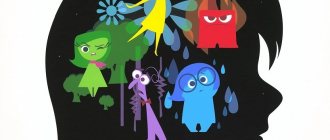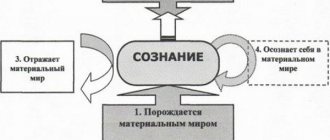Updated July 24, 2022 810 Author: Dmitry Petrov
Hello, dear readers of the KtoNaNovenkogo.ru blog. Today I want to talk about a very interesting thing - a person’s perception of the world around him and other people.
Let's take a look at this process from a psychological point of view to understand its essence. We will find out what properties it has, what types it is divided into, what errors sometimes arise and how a person perceives another person. I hope it will be interesting.
Perception - what is it?
The term "perception" can be considered in two contexts. In one of them:
Perception is the process through which images of the surrounding world are formed, a reflection of reality in the psyche.
In this case, the concept is a verb, that is, an action.
In another context, perception is a noun, an object, a result, an image itself.
Most often, science (what is this?) uses the first version of meanings. We will rely on it in this article.
Perception is synonymous with the word perception, which, in turn, translated from Latin perceptio means subjective, sensory knowledge of the environment. Words such as appreciation, acceptance, contemplation and others are also used equally.
What is perception in simple words? In the process of life, a person does not stop learning about the world. For example, in a store you are interested in some thing: you take it in your hands to understand what its texture, weight, density, color, smell, taste and so on, that is, you use the necessary senses (food - taste, book - vision).
All these characteristics cause different sensations, which together give rise to the image of the object. The process of cognition, therefore, is perception.
It is important to note that perception in psychology is not just the sum of sensations. It also includes our individual knowledge and beliefs about the world. This phenomenon is closely related to other mental processes: memory, thinking, speech, motivational sphere and attention.
Objectivity in philosophy
In philosophy, objectivity is understood as the totality of many subjective opinions regarding something. However, it is impossible to collect all the options, and even more so it is impossible to avoid contradictions. Absolute truth (objectivity of truth) is the maximum understanding of what is happening. But, as philosophers note, it is impossible to achieve absolute truth. For every objective opinion, you can always find several equally objective objections.
Socratic method
Many philosophers have dealt with the problem of searching for truth, but Socrates made a special contribution. In his opinion, each person can have his own truth, his own idea of something, but the truth is always the same. And it consists of several subjective relationships. That is, absolute truth, according to Socrates, is always somewhere in the middle between two opposing points of view (between two relative truths).
The philosopher even developed his own method for searching for truth. It is still used today to resolve disputes, dilemmas, and complex problems. Have you heard the expression “Truth is born in dispute”? It just came from Socrates. He drew other people into dialogue, challenged their opinions, constantly put forward new assumptions and facts, and eventually arrived at the truth.
The Socratic method is a method of conversation or dialogue. The philosopher himself began them with the well-known phrase “I know that I know nothing, but others don’t know that either.” Using facts and light irony, Socrates challenged his opponent’s opinions until the second participant uttered the phrase “You’re absolutely right, Socrates.”
The objectivity of good in Plato's ethical ideas
Plato paid special attention to the problem of good and evil (works “Phaedo” and “Republic”). In his writings, he defined what objective good is. And this is a perfect society.
Let us briefly consider Plato's theory. She identified three types of virtue, three types of human soul:
- Intelligent soul. Virtue is wisdom, that is, true knowledge. These are rulers, sages, philosophers. They see true ideals and try to do everything to increase goodness.
- Emotional soul. Virtue - courage, bravery, sense of duty. These are warriors, guards.
- Sensual soul. Virtue is physical strength. These are simple workers who provide the material life of the state.
Plato noted that an isolated type of soul does not occur. All three types live in every person, but one of them predominates.
At the same time, Plato distinguished three classes (from highest to lowest): rulers, warriors and workers. The characteristics are the same (corresponding to soul types from 1 to 3).
The goal of the state and any society is to achieve truth, justice, and objectivity. This is good. Virtues (conditions) that help in this:
- measure in everything;
- equality of women and men;
- the absence of family and private property among sages and warriors (so as not to be distracted from management and protection);
- inaccessibility of money for the upper class (payment in kind, so that there is no temptation to accumulate funds).
Thus, to put it briefly and simply, in modern language, according to Plato, goodness is equality, prevention of corruption, a sense of proportion for everyone and in everything, a strict distribution of roles in society. Philosophers, psychologists, and sociologists note that Plato’s philosophical ideas about the ideal state and objective good cannot be realized.
Properties of perception
It is customary to distinguish 7 properties of perception:
- Selectivity is the preferential selection of one object against the background of others due to the impossibility of embracing a large number of them at the same time.
In a bookstore, you will sort through books one by one to decide which one is worth buying for further reading. When you have a specific one in your hands, at that moment all attention is focused on it: the reader examines it externally, reads the title, content, and skims through it. The rest seem to not exist, fade into the background. But as soon as interest in this publication disappears, attention moves to the next one. What was in the hands fades into the background. - Objectivity of perception – represents the assignment of an object to a certain category of environmental objects. For example, green, round, hard and sweet is an apple, a fruit, and green, long and growls is a crocodile, an animal.
Often the recognition process does not occur immediately: a person is forced to spend some time and additional effort to determine the type of object being studied (come closer, listen or smell).Recognition also divided into specific and nonspecific: the first is what is familiar to us (on the street I recognize my husband’s car). The second type helps to determine only the type of object, its superficial characteristics (on the street I see a lot of moving objects and identify them as cars, but I don’t know whose they are, their year of manufacture, history, etc.).
In this regard, objectivity influences human behavior: if you offer him a familiar scrambled egg for dinner, the latter will be quickly eaten. In the case where we have an unfamiliar product in front of us, the majority will most likely show caution - they will be more closely interested in the proposed dish.
- Apperception is expressed in dependence of image formation on mental experience and personal characteristics of the individual.
Simply put, people perceive the same object differently, based on their beliefs, attitudes, values and needs. The short video below shows this property of human perception in simple pictures that everyone sees differently: - Integrity is a property that demonstrates the fact that an image is always perceived as a whole based on the totality of sensations received from it. That is, it cannot be created by color or sound alone. The important factor here is movement. For example, a frog does not perceive a fly as a fly if it remains motionless, so it will not hunt it.
- Structurality lies in the fact that perception is not the sum of individual sensations.
The image is born only through their interaction. Each element becomes significant when related to the whole. For example, a large, iron thing floating on water is a steamship, a large and iron thing on rails is a train: replacing one element changes the image. Also, when a person listens to music, he does not perceive each note separately: he hears the whole melody. Playing notes in different order and key changes the entire melody. - Constancy is the relative constancy of surrounding objects.
Why relative? During the day, you can clearly see that your house is blue in color, but as night falls, it turns gray. At the same time, you know for sure that the house is yours, since you do not attach importance to the fact of changes in visual perception. If this property did not exist, then with the onset of night, screams of horror and despair would be heard everywhere: people would not recognize their homes, other landmarks would also be lost. - Meaningfulness is the awareness of objects and phenomena of the surrounding world. For example, if we see a spoon, we immediately understand what it is for and how to use it. This confirms the fact that perception is not innate: we learn it throughout life.
Imagination vs Visualization
Let's figure out why 99 percent of people can't visualize one bit. That is, 99 percent of people think that they cannot visualize one bit. But this is completely wrong, because 100 percent of people absolutely can visualize - they do it all the time, but they don't know that they are doing it!
This misunderstanding arises simply because visualization is generally poorly understood and taught. Visualization is very easy and does not take any learning time. This is a natural ability that everyone uses all the time.
I have encountered countless developmental problems regarding energy body manipulation and development methods. These problems greatly increase the difficulties encountered in any major energetic development, greatly lengthening the development time. Consequently, most people quit their jobs almost before they get any noteworthy results. Please note that I am using the term energy body simply as a synonym for the pure energetic aspect of the etheric body.
If you are part of a meditation or development group, ask people one-on-one how they actually do visualization. Pay attention to the slightly worried and shy looks you get, especially from those who teach. Most people, if they are completely honest, will admit that they have some problems with visualization or that they cannot do it at all. You will find a few lucky people who claim that they have no visualization problems at all. A lucky few can easily see with their mind's eye, visualizing exactly as if they were watching television with their eyelids closed. Few people are accidentally lucky with this type of visual ability - the majority are still affected by this widespread and self-propagating problem.
Visual ability of the Mind's Eye
The commonly used term visualization is the root of this problem.
Many teachers tell their students that with a little practice they should be able to see what they are visualizing. Unfortunately, of course, this is partly true, but it is not something that can be quickly learned by people except those with strong natural ability. In a nutshell: visualization is not a visual skill. You don't actually see what you visualize. If you see something, this is not visualization at all, but a type of ability - seeing in the mind's eye.
During any meditation or training that requires deep physical and mental relaxation and visualization, some people develop partial clairvoyance, waking lucid sleep, visual ability, or all three. The visual abilities of the mind's eye allow these people to actually see what they are visualizing, similar to a lucid dream state in which the conscious mind takes creative control of the dream environment. Clairvoyance and lucid dreaming are visual abilities.
Now there is nothing wrong with using advanced visualization abilities such as lucid dreaming with clairvoyance. It's very interesting and useful, but it's not an ability that most people can easily learn.
The problem comes when this type of creative visual ability becomes the accepted norm and people think that they must develop this visual ability in order to visualize properly. When one person, especially if it is a group leader, tells the rest of the group that they can actually see what they are visualizing, the rest of the group thinks that they are doing something wrong or that they lack natural ability and therefore cannot maintain it at a high level. If they continue to believe this, they will never be able to develop themselves to any significant extent.
A similar problem can arise when beginners are exposed to more advanced students or those who believe that visualization is a truly constructive use of the imagination. These people, although they see nothing at all when they visualize, use visual terms to describe their visualization or non-physical perception.
Development groups and the New Age movement tend to use visual terms, I see, I saw, quick glance. Instead, more precise terms should be used, such as I sense, I feel, I intuit, I intuit, I imagine, or visualization.
Now let's look at the other side of the problem: the vast majority of energy work techniques, energy development exercises and projection techniques taught today rely entirely on visualization techniques. Without any viable alternative, you obviously won't be able to do the development exercises properly and simply won't be able to develop yourself if you have a problem with "optical visualization". Thus, an accurate understanding of what visualization is and is not becomes a cornerstone of all aspects of development. Still, any person, without exception, will be able to visualize easily and perfectly if he is taught it correctly.
The developmental exercises and techniques in this book are not based on optical visualization, but on a short, non-optical visualization system that I have developed called tactile visualization, based on the active use of touch and the senses of the mental body. It is very easy to learn and extremely effective, much more effective for energy manipulation and development than any visualization based methods.
People who actually see what they visualize may be a little confused when they start using the non-visual tactile visualization techniques in this book unless they change their habit of doing so. They will have to stop trying to see what they are doing and will have to learn to feel what they are doing in these techniques in order to work effectively. If you, like most people, cannot visualize very well, you will actually be able to work very well with these new techniques.
Types of perception
The world is huge and diverse: each object or phenomenon is perceived through different receivers or analyzers, one of which is always leading.
When reading printed information, we rely more on vision, when eating - on taste sensations, hugging a person, we perceive him through the body, tactile contact.
There are several classifications of types of perception:
By modality:
- visual – creating a visual image:
- auditory – receptivity to sounds;
- tactile perception – reading information about the environment through tactile sensations;
- olfactory – distinguishing odors;
- gustatory – building an image using taste sensations.
Depending on the host analyzer:
- Simple sight is sight, hearing and touch. All healthy people have this type of perception. Depending on which analyzer a person uses most often, he is classified as a group of people with the corresponding type of perception: kinesthetic (sensations, movement) - a person (he is called a kinesthetic) reads information, relying most on the movement of objects, the sensations that these objects call. In his speech the words “take”, “grasp”, “try”, “feel”, “feel” are constantly heard;
- auditory (sound) - most of the perception of the world occurs through hearing. Such people often say “I hear”, “listen”, “listen”, “sounds” and others;
- visual (vision) – the leading receiver is the eyes: “I see”, “I look”, “I imagine”.
Thus, by listening to how a person speaks, one can calculate his individual type of simple perception. This knowledge will help solve the eternal problem of interaction - the inability to understand each other. The latter occurs precisely because of different abilities to “see” the world.
By updating method:
Perception in psychology can also be voluntary or involuntary . The first necessarily has a goal, intention and awareness of actions. For example, a child reads a book and understands why he is doing it. He directs all his attention to this activity, focuses his vision on the letters, and holds the textbook in his hands.
Involuntary perception is caused by the environment, not by the individual's goals. A striking example: the reaction of the leg to a neurologist’s hammer, with which he hits under the kneecap to check physiological reactions.
Using Your Imagination
We, without exception, are able to easily create and visualize the most complex scenario in our minds without preparation.
Over the years I have asked many people who claim that they cannot visualize whether they ever remember, fantasize, daydream, or imagine things. The answer was always: “Yes!” Of course, everyone is capable of using the imagination to construct complex and detailed fantasies in the imagination. So let's try it right now: When we say “imagination,” we mean visualization. When we say “visualization” we mean imagination. Imagination and visualization are twin brothers. And neither is truly a visual ability. Visualization is not a visual ability. You don't actually see what you visualize - just like you can't actually see your imagination or fantasy. True visualization is pure imagination. Imagination is the generator of all dreams and fantasies, new experiences, memories or any fiction based on memory. Indeed: You cannot see memories or fantasy creations. But they are so vivid and lifelike that they are indistinguishable from the more visual creations of the imagination. Mental imagination and mental visualization are terms that are much more useful and workable when using the imagination to construct detailed fantasies or visualizations.
Memory plays an important role in constructive imagination. Imagination is based on memory. If you've ever lost something, you've probably tried to recreate your previous actions in your mind to remember where you lost it. You played them out using your imagination, working through all your actions step by step. This is the ultimate visualization, mental visualization based entirely on memory.
A typical example: get up and go to the kitchen, take a sip of water and come back. As you do this, carefully take into account everything you do, see and feel along the way. Then sit down, close your eyes and relax. Remember everything you just did from the very beginning, and restore this sequence of actions in your mind - in your imagination. It is important to feel everything as if you are actually doing it. This is very similar to creating a fantasy based on real life events.
Remember how you got up from your chair, what the room looked like, how it moved around you when you turned around; remember your steps as you walked into the kitchen, what you saw and felt when you arrived, and what your hand looked and felt like when it reached for the glass; remember how the water filled your stomach, remember what the water tasted like and how it smelled and felt, remember how you put the glass down, walked back to your original place and sat down again. Do it in real time, take about the same amount of time to recreate it in your mind as it actually takes to do it.
You cannot actually see these actions, but you can easily remember and feel them. This is very similar to an ordinary fantasy that you have created in your imagination. You can almost see a good fantasy, that's how real it can be. Fantasies are built by the imagination. Today it is more often called visualization.
Relax again and close your eyes, try to build a completely fictitious scenario in your imagination, taking all the necessary elements from memory. Think about what it's like to comb your hair. Rehearse these actions in your mind, in your imagination, without actually performing these actions first. Imagine that in front of you is a table with a comb on it. Carefully feel yourself reaching (without actually moving your hand), taking an imaginary comb, slowly lifting it towards your head and combing your hair. Fully feel the trajectory of your hand in your imagination. Feel your hand combing the comb through your hair many times without actually moving your hand. This is only constructive imagination (fantasy or visualization). Finally, return the imaginary comb to the imaginary table.
You should feel all these movements when you do them in your imagination. Don't try to see them, imagine and feel them. It may help if you imagine yourself using the hands of your projected double and instructing him to perform these actions.
You have just successfully created a purely imaginary construct (complex fantasy or visualization) in your mind. Any visualization or exercise of imagination, no matter how long or detailed, is simply an extended version of what you just did in these two exercises.
The last constructive exercise of the imagination: close your eyes, remember how you felt the urge to run barefoot across a beautiful lawn surrounded by trees, bushes and flowers on a beautiful sunny day. Build it from your memories in your imagination, as if this creation of yours exists independently. Think back to a time when you actually did something similar, or remember a relevant scene from a movie.
Feel yourself walking across the lawn towards a massive ancient tree with heavy, leafy branches hanging down from it. Some of these branches touch the ground. Imagine how the tree gets bigger and bigger as you get closer to it. Walk through the small gap in the branches, now you move into the soothing shade under the cover of its leafy branches. You are standing in a hidden niche behind the branches. You can smell living wood and tree leaves, mixed with soft earthy scents of moss, bark, fallen leaves, and damp earth.
As you walk around the large ancient trunk, you see the shape of a comfortable chair formed from the tree and its massive roots. Soft green moss is everywhere and you can feel its pleasant softness under your feet. Moving along it, you sit in this chair and relax. Leaning back, put your hands behind your head, close your eyes and listen, feel and smell the hidden world around you. You hear the wind softly whispering and murmuring through the branches. You hear the fluttering of small birds, the whistling and buzzing of insects buzzing around, chirping and calling to each other. Sit for a while, feel completely relaxed, at peace with the world, and let all your worries and problems burn with a blue flame.
You have just successfully recreated a detailed fantasy scene in your mind. It was full of action, sights, sounds, smells and touches, based entirely on your memory and imagination. This is what you should do during any guided meditation in which you are guided by a voice through a fantasy scenario while music and special effects stimulate your imagination and transport your mind there. You don't actually see what you visualize or imagine, but you can still generate detailed perceptions in your mind's eye.
Supplement for the Blind
If you are blind and cannot visually imagine, then convert the exercises in this book into tactile imagery exercises, replacing the colors, scenes, and visual descriptions with those from your own blind memory.
Use your memories of the perception of a beautiful walk in the park and adapt them to this training. Expand the exercises to take into account increased perceptions of sound, smell, texture, taste and spatial awareness. This can be easily done by constructive imagery or visualization exercises and can also be done during any guided meditation containing visual details or instructions. Please note: Some of these early exercises may cause slight feelings of dizziness, localized spinning in the abdomen, falling in the chest area and even some deep tickling sensations in the bones, arms and legs. Many of these exercises move the mental body point beyond the physical body, which can often shock the etheric body and cause sensations of energy movement.
Errors in perception (illusions)
There is nothing perfect in the world, and perception is no exception. For various reasons, this process can “fail” and give the individual erroneous images that do not correspond to reality.
There are two types of such violations:
- illusions are a perverted perception of existing objects and phenomena. Illusions, in turn, are: affectogenic - they are caused by feelings and emotions. For example, an anxious person may see an approaching maniac or monster in the shadow of a tree, hear a threat in someone else’s speech, a shy person will see criticism and shaming everywhere;
- pareidolic - the emergence of fantastic images when interacting with reality (blood in a glass instead of water, beetles instead of dirt stains). This type of illusion is a precursor to hallucinations.
This disorder is independently present only in mentally ill people - psychotics (for example, schizophrenics). The only condition under which a normal person can temporarily see hallucinations is a forced change in mental state (hypnosis, drugs).
Person's perception by person
An interesting picture emerges when it comes to the perception of a person by a person. Interesting because in reality we don’t see each other when we first meet as we really are, and there are many reasons for this.
Have you noticed that when you meet a person who has a pleasant appearance for you, you automatically consider him kind and good? And if he has external similarities with his beloved friend, mother, brother, then sympathy for him increases significantly?
The perception of others is determined by many more factors that we consciously or not pay attention to: posture, gestures, speech culture, manners, behavior, his profession, status and others.
So, there are 4 ways to interpret the characteristics of other people:
- emotional – beautiful, which means good, sincere;
- analytical - frowning eyebrows, sharp cheekbones “characterize” an evil person;
- perceptual-associative - similar to a harmful neighbor, which means just as unpleasant;
- social-associative – attributing social qualities to a person based on appearance. Torn, dirty clothes “tell” us about a dysfunctional personality and makes us want to stay away. But a neat suit and an expensive car elevate a stranger in our eyes.
How to perceive information objectively?
It should be understood that a person evaluates all the information he receives. This means that completely objective information does not exist. But by an objective examination of the situation, one can understand its multilateral assessment.
In order to avoid the temptation to perceive information one-sidedly, firstly, you should obtain it from as many sources as possible, and secondly, analyze the data received and try to find another opinion that is different from yours.
To make an objective decision based on the information received, you should not do this right away. The ideal would be to wait a few days, give your brain time to comprehend, and let your emotions calm down a little, and then re-evaluate the situation with “fresh” eyes.









